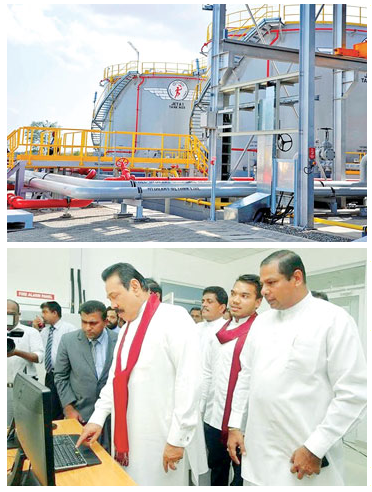
Sunday, 29th June 2014
By Shirajiv Sirimane
The Mattala Rajapaksa International Airport (MRIA) and the Hambantota Port projects are two mega development programs that were indeed much looked forward to during recent times.

The opposition meanwhile expects planes to be queueing for their turn to touch down at Mattala and ships lining up in the seas to dock at the Port from the day the two projects were opened, just like in the Pettah Bus station.
However, both these development projects were built with long term plans to bring economic prosperity to the nation.
Already a few aviation experts know that the economic benefits from MRIA are being reaped. Due to the new airport, a new landing facility has been opened to the world, and aircrafts are now flying over MRIA aware of its availability in case of emergency. All these flights that are now going over Sri Lanka have to pay for each passenger on board and also for the cargo that they carry!
In a bid to get additional revenue by refuelling, the MRIA also introduced a fuel hydrant system and aviation refuelling terminal at MRIA in Mattala.
The automated fuel hydrant system along with the state of the art aviation refuelling terminal facility was constructed at a cost of Rs. 5 billion ($ 40 million). The Mattala airport project drew attention over the absence of a proper refuelling facility for the aircrafts.
The functioning of the automated fuel hydrant system along with the state of the art aviation terminal facility will become an important milestone in the aviation industry in Sri Lanka in many ways for the economic development, employment generation and regional development in the near future, a Government spokesman said.
In addition to the refuelling unit, the facility comprises a high-tech computerised refuelling unit, a fire hydrant system and fire hazard identification system.
The fully computerised oil storage terminal has the capacity to store three million litres of aircraft fuel. The refuelling facility can supply fuel to the world's largest passenger aircraft such as an Airbus-340 which can take in 310,000 litres of aviation fuel.

The required Jet-A1 fuel will be initially supplied by 33,000 litres capacity Road Tankers from the CPSTL Kolonnawa installation, until the Sri Lanka Port Authority (SLPA) aviation storage tank farm at the Hambantota Port facility is ready for operations. A pipeline corridor from Hambantota Port to MRIA over a length of around 32 kilometres has been allocated by the Road Development Authority for a Jet-A1 fuel transfer pipeline to be constructed in the future, based on the increasing demand for Jet-A1 fuel at MRIA.
Three tanks at the oil storage facility have been leased out to the Ceylon Petroleum Corporation (CPC) for aviation fuel to be supplied to the Mattala International Airport and the other three tanks have been leased out to Litro Gas Company for LP gas storage.
Self-funded
According to the Government, the aviation refuelling facility incorporated in to the overall plan of airport and aviation services in Sri Lanka, and in the design of the Hambantota International Airport (HIA) by China Harbour Engineering Company (CHEC) did not have a fuel hydrant system and the required capacities in the fuel storage tanks and associated facilities, required for an international airport of this nature.
Therefore, the CPC and the Ministry of Petroleum Industries undertook the task of building a state of the art fuel hydrant system and an aviation refuelling terminal with the required storage capacities of Jet A1 fuel in 2010. The total project has cost CPC nearly Rs. 5 billion using its own funding.
Initial design of the fuel farm was only adequate for a very small airport and not at all sufficient for an international airport which requires a large storage to maintain an adequate buffer stock for any eventuality, the Government said.
The fuel hydrant system within the apron area was constructed by the main airport contractor China Harbour Engineering Company (CHEC) for a negotiated price of $ 7,175,326.13 without any variation claims approved.
The construction of the aviation terminal and the interconnecting pipelines of 1.2 kilometres long was assigned to Amana Pipeline Construction LLC of Dubai, UAE on a competitive tender basis with Cabinet approval for $ 31,251,504.02 which has been successfully completed without any extra cost to CPC.
Meanwhile, President Rajapaksa also declared open the oil tank farm and commissioned ship bunkering operations at the Hambantota Port.
The oil tank farm, comprising 14 tanks, was constructed at the Hambantota Port with an investment of US$ 76 million
The farm has eight tanks for fuel bunkering facilities for vessels, three tanks for aero fuel and three tanks for storing LP gas. The 14 tanks will also have an overall capacity of 80,000m3.
The project is composed of five up-right tanks with dome in 10,000m3, three up-right tanks with dome in 5,000m3, three up-right tanks with dome in 3,000m3, three spherical LPG tanks with 2,000m3 and all necessary auxiliary facilities, according to a SLPA statement.
The tank farm will initially handle 55,000 tonnes of shipping fuel with eight tanks and is expected to add further 100,000 tonnes under the second phase.
It is envisaged that many of the 4,500 oil tankers would anchor at Hambantota for bunkering, ship repairing and also to purchase food, water, medical supplies as well as logistics, Wickrama said.
The Sri Lankan government has decided to keep the port open for the school children and other visitors to witness fuelling of ships.
Hambantota Port brings in revenue
MRMRP has received 91 vessel calls for the period from January to May this year against 35 calls for the same period last year indicating a positive change of 160.0 percent. The cargo handled at the port for the same period this year is 102,558 tonnes against 21,542 tonnes for the same period last year that indicates a positive change of 376.1 percent. MRMRP also received 87 RO-RO vessels from January to May this year against 35 such vessels for the same period last year pointing to a positive change of 148.6 percent. The total number of motor vessels handled for the same period this year at MRMRP is 72,612 units against 13,186 units for the same period last year pointing to a positive change of 450.7 percent.
During the period this year MRMRP has handled 14,019 domestic and 58,593 transshipment units in RO-RO operations ringing in revenue to the country.
To date all developmental activities at MRMRP are being successfully carried out with the supervision of Project Minister of Highways, Ports and Shipping Rohitha Abeygunawardena and instructions by Dr. Priyath B.Wickrama, the Chairman of SLPA.




